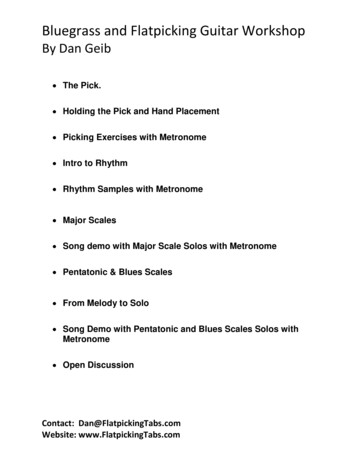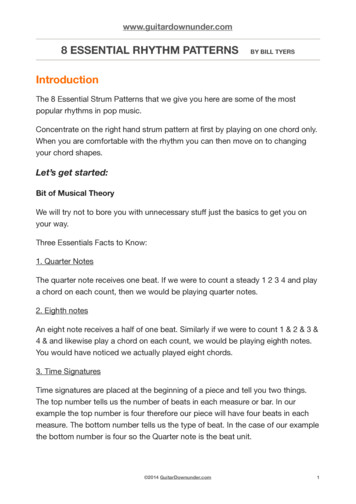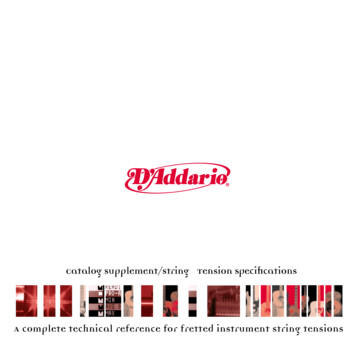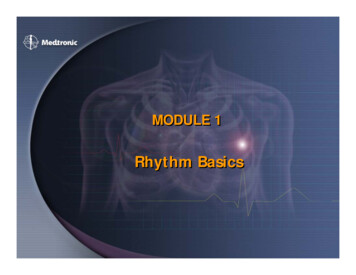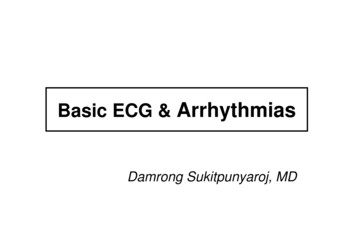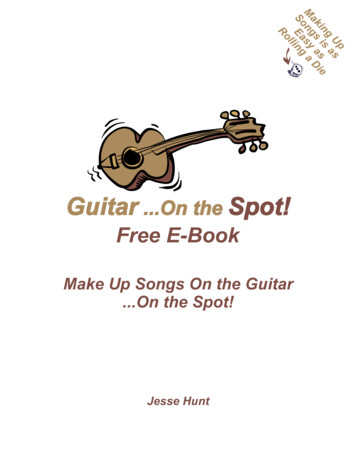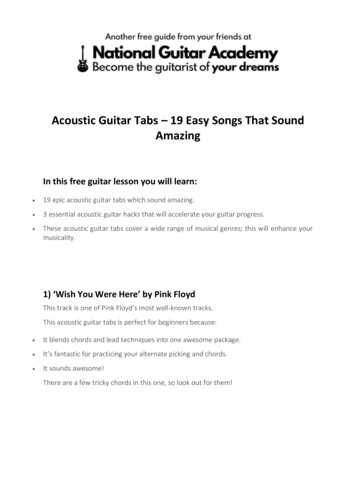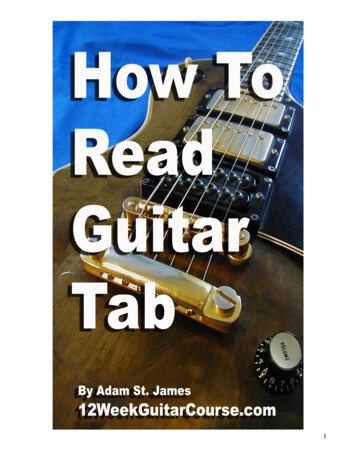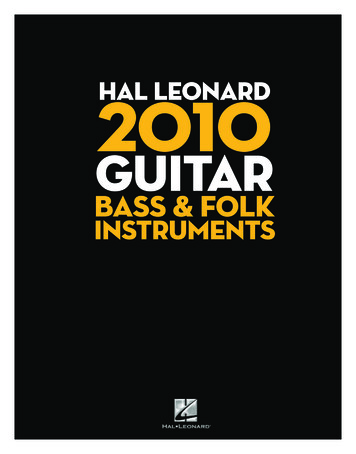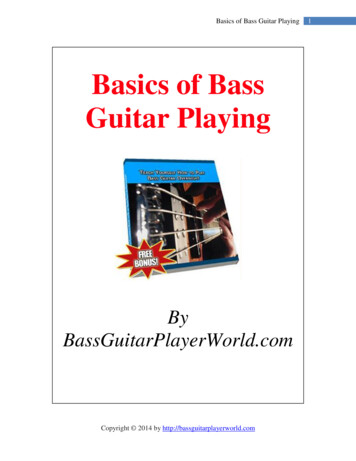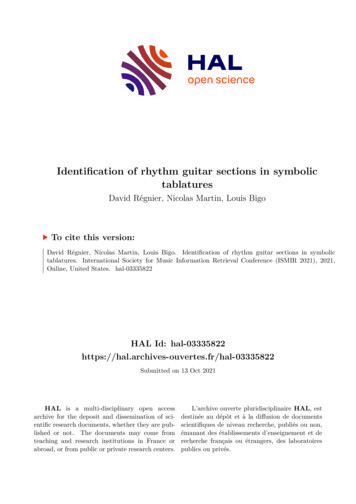
Transcription
Identification of rhythm guitar sections in symbolictablaturesDavid Régnier, Nicolas Martin, Louis BigoTo cite this version:David Régnier, Nicolas Martin, Louis Bigo. Identification of rhythm guitar sections in symbolictablatures. International Society for Music Information Retrieval Conference (ISMIR 2021), 2021,Online, United States. hal-03335822 HAL Id: 3335822Submitted on 13 Oct 2021HAL is a multi-disciplinary open accessarchive for the deposit and dissemination of scientific research documents, whether they are published or not. The documents may come fromteaching and research institutions in France orabroad, or from public or private research centers.L’archive ouverte pluridisciplinaire HAL, estdestinée au dépôt et à la diffusion de documentsscientifiques de niveau recherche, publiés ou non,émanant des établissements d’enseignement et derecherche français ou étrangers, des laboratoirespublics ou privés.
IDENTIFICATION OF RHYTHM GUITAR SECTIONSIN SYMBOLIC TABLATURESDavid Régnier1Nicolas Martin2Louis Bigo11Univ. Lille, CNRS, Centrale LilleUMR 9189 CRIStAL, F-59000 Lille, France2Arobas Music, Lille, Francelouis@algomus.frABSTRACTSections of guitar parts in pop/rock songs are commonly described by functional terms including for example rhythm guitar, lead guitar, solo or riff. At a low level,these terms generally involve textural properties, for example whether the guitar tends to play chords or singlenotes. At a higher level, they indicate the function the guitar is playing relative to other instruments of the ensemble,for example whether the guitar is accompanying in background, or if it is intended to play a part in the foreground.Automatic labelling of instrumental function has variouspotential applications including the creation of consistentdatasets dedicated to the training of generative models thatfocus on a particular function. In this paper, we proposea computational method to identify rhythm guitar sectionsin symbolic tablatures. We define rhythm guitar as sectionsthat aim at making the listener perceive the chord progression that characterizes the harmony part of the song. A setof 31 high level features is proposed to predict if a bar in atablature should be labeled as rhythm guitar or not. Thesefeatures are used by an LSTM classifier which yields toa F1 score of 0.95 on a dataset of 102 guitar tablatureswith manual function annotations. Manual annotations andcomputed feature vectors are publicly released.1. INTRODUCTION1.1 Guitar tablaturesAs many multi-stringed instruments, the guitar allows toplay a same note in multiple locations on the neck. Thelocation where the note is played, commonly designatedby the term position, is specified by the combination of astring name and a fret number. For example, the pitch A3can be played at fret 2 of the G string or at fret 7 of the Dstring. Guitar tablatures, as illustrated in Figure 1, aim atdisambiguating these positions by indicating the string/fretcombinations on which notes must be played. The choice David Régnier, Nicolas Martin, Louis Bigo. Licensedunder a Creative Commons Attribution 4.0 International License (CC BY4.0). Attribution: David Régnier, Nicolas Martin, Louis Bigo, “Identification of rhythm guitar sections in symbolic tablatures”, in Proc. of the22nd Int. Society for Music Information Retrieval Conf., Online, 2021.of the positions relates to playability and to some extent tothe guitarist playing style [1].1.2 Functions in guitar tablaturesSimilarly to other instruments like the piano, the role ofthe guitar in a pop/rock ensemble can potentially be associated with different functions over a song. Most of the time,these functions can be gathered within two categories being accompaniment and melody, generally designated bythe terms rhythm guitar and lead guitar. Although notcentral in this paper and less frequent in the context of apop/rock ensemble, it is worth noting that the guitar, asthe piano, can simultaneously perform accompaniment andmelody. The piano will typically split the two functionsinto left hand and right hand while the guitar will generally use a specific playing technique called finger picking.A more general way to describe the function of the guitar is to estimate if it is thought to be perceived in the background or in the foreground of the song. Accompanimentparts will generally fit the first category as they often aimat supporting a main musical part like a singing part or aninstrumental solo. Although melodic parts are generallythought to be perceived in the foreground, it is not uncommon for a lead guitarist to play an accompanying melody,possibly improvised, during singing sections. Examplesof this behavior include the verses of the song What’s Up(4 Non Blondes) or the bridge of the song Cryin’ (Aerosmith).Rhythm guitar sections in the pop/rock repertoiremostly consist in (repetitively) realizing a chord sequence.Figure 1a illustrates two bars of rhythm guitar. In contrast,lead guitar appears to be less well-defined as it can be alternately associated with solo parts, as in Figure 1b, riffsand licks, or hybrid accompanying parts not directly relatedto the underlying chord sequence. In this work, we focuson the detection of rhythm guitar sections. Rhythm guitarsections are defined as guitar sections that aim at makingthe listener perceive the chord progression that characterizes the harmony part of the song. In pop/rock style, suchchord progressions can often be indicated independently aschord symbols accompanying melodies and lyrics.Although rhythm guitar looks more easily definablethan lead guitar, it is common to find ambiguous guitar
rhythm guitar sections might be more performant in generating, analyzing, or transcribing such sections. In contrast,studying guitar playing techniques like bends, hammeron/pull-off, and tapping will benefit from being done ona corpus of guitar solos as they appear predominantly inthese sections.(a) Extract of a rhythm guitar section from Space Oddity (David Bowie)2. RELATED WORK2.1 Guitar tablature modelling(b) Extract of a solo section from Another Brick In The Wall (Pink Floyd)(c) An ambiguous extract from Sultans of Swing (Dire Straits)Figure 1. Three guitar tablature extracts.sections standing at the border of what rhythm guitar couldbe. Figure 1c illustrates this ambiguity with an extract ofSultans of Swing (Dire Straits). A rock song can typicallybegin with a guitar riff played as a foreground part, whichis then repeated as a background accompaniment of a vocalverse. One example of this is the famous introducing riff ofthe song Highway to Hell (AC/DC) which switches fromforeground to background as the vocal part begins. Ambiguities can also appear with punctual arrangement partsthat are generally added during studio recording sessions.The way ambiguous sections are labelled should becarefully considered if this labelling aims at separating asub-corpus intended to train a rhythm guitar generativemodel. On one hand, a strict labelling would reach to aconsistent sub-corpus with limited variety. On the otherhand, a more flexible labelling would reach to a sparsersub-corpus but richer in variety. This aspect will be furtherdiscussed in Section 4.3.1.3 Applications in MIRModeling instrumental function contributes to improvevarious applications in Music Information Retrieval including computational music analysis and generation.Identifying textural features that contribute to a functionimproves our knowledge in music theory and our understanding of musical style. Systematic studies bring our attention on unexpected and ambiguous cases which eventually encourage reconsiderations of common definitions.Automatic function identification can also guide the division of large corpora into function-specific sub-corporathat will facilitate the effective training of machine learning models. For instance, a model trained exclusively onMIR research on guitar tablatures predominantly relates toautomatic fingering, style analysis, and generation.The automatic fingering task results from the fact that asame note can generally be played at multiple locations onthe neck of the guitar. This task therefore consists in estimating a string/fret combination for each note of a scorein order to optimize its playability. The fingering problem has been approached with various methods includingHMM from audio signal [2] or symbolic scores [3], andvisual detection [4].Guitar tablature automatic analysis includes the detection in audio recordings of specific playing techniques(bends, hammer-on, pull-off, etc.) [5, 6]. Analysis of audio guitar recordings also include automatic transcriptionof tablatures [7] based on the training of CNNs on guitar recording spectrograms, that tackle both the pitch andfingering estimation. Automatic analysis of symbolic tablatures include guitarist style modeling with Markov models [1] or directed graphs [8], as well as the study of predominant fretboard positions [9].Guitar tablature generation has been approached withvarious methods including HMMs to generate guitar arrangements from audio polyphonic music [10], integerprogramming to generate blues solos [11], and transformerneural networks to generate fingerpicking tablatures [12].Of particular relevance in the context of this research, guitar tablature generation has also been limited rhythm guitarand lead guitar [13, 14] with probabilistic methods.2.2 Musical function identificationThe complementarity between rhythm and lead guitar sections in pop/rock tablatures can be generalized to the notion of musical function in musical scores. Identifyingwhether a section of a part corresponds to background accompaniment or to foreground melody relates to texturemodeling [15, 16] which has been rarely addressed in symbolic scores so far. In audio recordings however, a numberof works has been achieved to detect solo sections [17–19],which can employ similar techniques as vocal activity detection [20]. Solo detection contributes to the task of structure estimation for which a number of research has beendone either on symbolic [21] and audio data [22].Particularly related to this research, guitar playingmodes (bass lines, chord comping and solo melody improvisations) can be detected in audio recordings with signalprocessing features [23] but to the best of our knowledge,there is no research detecting guitar-playing modes fromsymbolic tablatures.
3. HIGH LEVEL FEATURESRhythm guitar is considered in this work as a category oftablature sections that aim at making the listener perceivethe chord progression underlying to the song. This sectionpresents a set of 31 features that are designed and evaluatedto detect such a behavior.3.1 Bar-level labelsAlthough the role of a guitarist in a pop/rock song canstrictly be limited to rhythm or lead guitar, it is commonto see guitar tablatures switching between rhythm parts andlead parts over a same song. A number of bands have a single guitarist who alternates during a song between accompanying rhythm parts, and riff /solo lead parts. A globallabelling of guitar tablatures as rhythm or lead might therefore lead to approximations and wrong interpretations. Incontrast, trying to characterize the role of the guitar atthe beat level would require unnecessary complexity asthese functional labels tend to span over much larger timeframes. In this work, we propose to assign rhythm guitarlabels to bars of a tablature.note features# notes(7e 2)single notes (1e 3)min pitch(3e 3)max pitch(8e 2)mean pitch(2e 3)pitch ambitus (1e 3)pitch variety(2e 3)min interval(3e 1)max interval(1e 1)interval var(2e 2)duration var(1e 2)chord featureschords (2e 3)# 2-chords(1e 1)# 3-chords(3e 2)# 4-chords(5e 2)# 5-chords(2e 2)# 6-chords(9e 1)chord variety (9e 2)m/M triad (5e 2)fifth interval (1e 2)tab featuresmin fret(2e 3)max fret(2e 3)mean fret(2e 3)min string(3e 3)max string(4e0)mean string(7e 2)l-r(s) (1e 2)l-r (100%) (1e 2)w.b(s) (6e0)bend(s) (2e 3)l-h vibr(s) (8e 2)Table 1. Features describing tablature bars for the rhythmguitar detection task. Binary features are indicated witha . The importance of each feature in the dataset is indicated by its ANOVA F-value.3.2.3 Guitar tablature specific featuresFor each bar, the min/max/mean values of both frets andstring are computed. Playing technique features respectively include the presence of at least one let-ring (l-r), vibrato, whammy bar (w.b) and bend indication. A featureindicating whether the whole bar is covered by a let-ringindication is added.3.2 High level features4. EXPERIMENTSThe 31 high level features described in this section andsummarized in Table 1 are intended to be computed at eachbar from raw tablature informations. These informationsinclude note pitches, onsets, durations, string and fret indications, as well as occurrences of some technical playingmodes specific to the guitar. Note that some features mayderive from combinations of others. For example, the pitchof a note can be deduced from its string and fret value.3.2.1 Note-related featuresNote related features include the number of notes in thebar, as well as the presence of single notes (i.e., not playedsimultaneously to any other). Pitch-related features include mean/min/max pitch, pitch ambitus and pitch variety (i.e., number of distinct pitches). Pitch interval relatedfeatures include min/max interval found between 2 successive single notes and interval variety. Finally we added thevariety of note durations found in the bar.3.2.2 Chord-related featuresA chord is considered here as a set of at least two notes thatare plucked simultaneously. Note that arpeggiated chordsare generally notated in guitar tablatures as successive single notes labeled with a let-ring indication. Arpeggios aretherefore not included in this definition of chords.Chord related features include the presence of chords,the number of distinct chords and more specifically thenumber of n-note chords with n in [2.6]. Two additionalfeatures indicate wether a triad (either minor or major) or afifth interval can be formed with the whole set of notes inthe bar.The detection of rhythm guitar bars is formulated asa binary classification problem with two classes beingrhythm-guitar and other. Each bar is described bythe set of features presented above. A classifier is thentrained to predict the label of a bar from its feature values.4.1 Annotated datasetFor this work, 102 guitar tablatures in the Guitar Pro format from the mySongBook corpus 1 were analyzed, annotated and checked by two musicians experts in the pop/rockstyle. Selected tablatures are mostly in the pop/rock stylewith a few exceptions in swing/jazz. Only tablatures of sixstrings with standard tuning (E3 A3 D4 G4 B4 E5 ) wereincluded in the annotated dataset. Among the 7487 nonempty bars (60% of the whole dataset), 6051 (82%) werelabeled as RhythmGuitar (the other 1368 ones werecomplementarily labeled as other). Different functionswere identified within this complementary class including solos, licks, riffs and studio arrangements. No fingerstyle tablatures were included as this playing style generally mixes both accompaniment and lead melody, makingits annotation ambiguous.Raw tablatures are not available due to legal constraints.However, computed features and manual annotations arereleased 2 in an open licence .4.2 Feature analysisFile parsing and feature computation were performedwith the music21 python library [24] using a us.fr/data/
parser [25]. Figure 2 shows the value distribution of a selection of features extracted from bars of both classes inthe annotated dataset. To facilitate the comparison of thetwo classes, the histograms indicate the proportion of feature values in each class rather than the actual number ofbars. As expected, rhythm guitar and non-rhythm guitarbars appear to be respectively correlated with the presenceof chords (80% of rhythm guitar bars) and the presence ofsingle notes (92% of non-rhythm guitar bars). Non-rhythmguitar can also be distinguished by a lower number of notesand distinct chords. Rhythm guitar bars can finally be distinguished by a lower register that appears in pitch, fret,and string related features. An ANOVA Fischer test is performed for each feature as an indication of its correlationwith the two classes. The results are displayed on Table 1.4.3 Rhythm guitar prediction4.3.1 Evaluation measureThe choice of an evaluation measure of the performance ofclassifier that predicts whether a guitar tab bar is rhythmguitar or not varies depending on the way the result of theclassification is intended to be used.On one hand, maximizing precision penalizes false positives and potentially leads to a consistent rhythm guitarsub-corpus although possibly small and uniform. Such acorpus would facilitate the training of a model that is expected to produce typical, but not necessary surprising,rhythm guitar tablatures. On the other hand, maximizing recall penalizes false negatives and potentially leadsto a larger sub-corpus with more diversity although moresparse and including more debatable rhythm guitar examples. Such a corpus would be appropriate for the trainingof a model that aims at generating creative rhythm guitartablatures, at the expense of outputs that possibly divergefrom the common definition of rhythm guitar. Note thatfor a classifier that outputs a probability (like neural networks) moving the decision threshold, that is generally setby default to 0.5, could also be a way to balance betweenconsistency and variety.From an analysis point of view, improving our comprehension of what makes a rhythm guitar bar requires to takeinto account both false negatives and false positives, whichcould be achieved by using accuracy. As the dataset is unbalanced, we propose to evaluate the F1 score which is defined by the harmonic mean of precision and recall.4.3.2 Leave-one-piece-out evaluationTraining a machine learning model is often performed bysplitting the dataset into a training set and a validation set.As bars can highly repeat, in particular in rhythm guitarsections, all bars belonging to the same piece should belong to the same subset to avoid overfitting. The smallsize of our dataset lets us adopt a leave-one-piece-out validation process: given the dataset of n pieces, the model istrained on n 1 pieces and then evaluated on the remainingone. The process is repeated for the n pieces and the evaluation is therefore performed on the whole set of piecesof the dataset. The leave-one-piece-out method allows tochords/single notes presencenote chord featurestab featuresall featuresr.g precision0.860.950.950.96r.g recall0.880.940.930.94F1 score0.870.940.940.95Table 2. Precision, recall and F1 score obtained for thedetection of rhythm guitar (r.g) with a LSTM trained ondifferent set of features.maximize the quantity of training datas and evaluate themodel on the whole dataset.Different classifiers were tested including logistic regression, SVM, decision tree and random forest thanks tothe scikit-learn framework [26]. A Long Short-Term Memory model (LSTM) implemented with the Keras framework [27] happened to provide the best results. The LSTMhas 2 hidden layers of 75 and 10 units. An early stopping process was used to identify the optimal number of12 epochs. A batch size of 32 was used and bars werepresented to the model by subsequences of 5. It is not surprising to see a recurrent model outperforming standardclassifiers given that bars of the same label are likely to occur consecutively in the piece as outlined in section 5. Thecode is publicly provided 3 .5. RESULTS AND DISCUSSIONSDifferent sets of features among those presented in Section 3.2 were tested to evaluate the model. We first consider a baseline model that only looks at the presence ofchords and single notes in each bar. We then evaluate scorebased features (first two columns of Table 1). We thenevaluate tablature based features only (third column of Table 1). Finally, we evaluate a model taking into accountthe whole set of features. In addition to F1 score, Table 2displays the precision and the recall on rhythm guitar labelpredictions.The LSTM baseline model achieves a F1 score of 0.87.The LSTM model combining the whole set of featuresreaches a F1 score of 0.95, which outperforms other testedmodels including logistic regression (F1 0.93), decisiontree (F1 0,91) and random forest (F1 0,93). Althoughdisjoint, the score feature set and the tab feature set interestingly achieve similar performance. This can partlybe explained by the fact that pitch informations in scorefeatures can be derived from string fret combinations intab features. It is interesting to observe that string/fretand playing technics indications seem to counterbalancethe absence of chord related informations, although presumably crucial for rhythm guitar detection. It also worthto note that both these two feature sets almost yield to thescore obtained with the whole set of features which meansthat none of them much improves the other. In the following, we present wrong predictions obtained with the modeltrained with the whole set of features.3 https://gitlab.com/lbigo/rhythm-guitar-detection
Figure 2. Disitribution of some features on bars annotated with label Rhythm guitar (blue) and other (green).Figure 3 displays a comparison between reference annotations (top line) and predictions (bottom line) for a selection of tablatures of the corpus. Although the modelsucceeds in identifying large scale sections, it can still predict unlikely short sections, sometimes for one unique bar.For example, the model wrongly predicts unlikely shortrhythm guitar sections in the song Sultans of Swing (DireStraits). Similarly, it wrongly predicts unlikely short nonrhythm guitar sections in the songs Stairway To Heaven(Led Zeppelin) and You Only Live Once (The Strokes) asdiscussed below.have the same label and avoid the prediction of isolated labels, for example using a bidirectional LSTM. Example 4cis extracted from the song When The Sun Goes Down (Artic Monkeys). In this example, the guitar starts to play basssingle notes and produces a melodic line which is wronglyestimated by the model as non-rhythm guitar. This behavior could arguably be qualified as being at the edge of thecommon definition of rhythm guitar and it would be difficult to avoid this kind of wrong predictions without looking at the other tracks of the song (in particular the singingpart), which is out of the scope of this work.Figure 4 illustrates three examples of false negatives,i.e. rhythm guitar bars predicted as being non-rhythm guitar bars. Examples 4a and 4b are extracted from songs YouOnly Live Once (The Strokes) and Stairway To Heaven(Led Zeppelin). In these two examples, only the middlebar is wrongly estimated as non-rhythm guitar. Both thesebars have the particularity to be the final bar of a musicalphrase, leading to a new phrase beginning on the next bar.In these cases, the rhythm guitar punctually plays a shortmelodic lick often referred as a fill, which is not identifiedas rhythm guitar by the model. This kind of wrong predictions could probably be avoided by improving the facultyof the model to capture the tendency of adjacent bars toFigure 5 illustrates three examples of false positives,i.e. non-rhythm guitar bars predicted as rhythm guitarbars. Example 5a illustrates an extract of a solo part ofthe song Hotel California (Eagles) where the guitar repetitively plays arpegios of the underlying chord sequence.Altghough the played notes belong to a rather high register, the model is probably misled by the repetiveness, lowvariety and the presence of perfect triad as these featuresare often correlated with rhythm guitar sections. Example 5b consists in a short interlude between a solo sectionand the bridge of the song La Grange (ZZ Top). In thiscase, the function of the guitar seems to consist in doing atransition between two sections and could hardly be unam-
3 Doors Down - KRYPTONITE (E.Guitar III)4 Non Blondes - WHAT’S UP (E.Guitar I)(a) You Only Live Once (The Strokes)Arctic Monkeys - WHEN THE SUN GOES DOWN (E.Guitar I)Bob Marley - NO WOMAN NO CRY (E.Guitar)(b) Stairway To Heaven (Led Zeppelin)Dire Straits - Sultans of Swing (E.Guitar I)Django Reinhardt - MINOR SWING (A.Guitar I)(c) When The Sun Goes Down (Artic Monkeys)The Eagles - Hotel California (E.Guitar VIII)Figure 4. Examples of false negatives. The second bar iswrongly predicted as non-rhythm guitar on each example.Led Zeppelin - Stairway to Heaven (E. Guitar II)Metallica - NOTHING ELSE MATTERS (E.Guitar II)The Strokes - YOU ONLY LIVE ONCE (E.Guitar II)Figure 3. Comparison of manual annotations (top lines)and predictions (bottom lines) of a some tablatures of thedataset. Sections labelled as rhythm guitar are displayedin blue. Other sections are displayed in green. Empty barsare left in gray.referencepredictionr.g measuresr.g sections60515923101223mean r.gsection length7734isolatedr.g measures044Table 3. Comparison of consecutiveness of annotated andpredicted rhythm guitar (r.g) bars.(a) Hotel Califronia (Eagles)(b) La Grange (ZZ Top)(c) Minor Swing (Django Reinhardt)Figure 5. Examples of false positives. Second and thirdbars are wrongly predicted as rhythm guitar.6. CONCLUSIONSbiguously described as rhythm guitar or not. Example 5cis extracted from a solo section of the song Minor Swing(Django Reinhardt). The model is clearly misled by thesudden occurrence of chords here. As it is often the casegypsy jazz, the guitar punctually includes series of chordswithin a solo, that do not necessarily precisely feet the underlying chord sequence. This behavior typically lasts afew bars before the guitar goes back to melody.Table 3 illustrates the difficulty of the model to reconstruct continuous rhythm guitar sections. Although theproportion of rhythm guitar bars predicted by the modelis close to the one of the reference, these bars are groupedin smaller and more numerous sections. The model particularly tends to detect isolated rhythm guitar bars althoughthe reference annotation do not include any of them.This study improved our understanding of which featurescontribute to a rhythm guitar section. We believe that thisapproach can be used to separate a corpus of pop/rock guitar tablatures into consistent sub-corpora dedicated to tablature generation limited to a specific function.The method presented here could benefit from severalimprovements. A finer tuning of the LSTM, or the useof a bidirectional LSTM, would probably better capturethe tendency of adjacent bars to have the same label andtherefore to limit isolated predictions which appear to bevery unlikely across the corpus. Futur works also includeadding features that look at more structural aspects of thesong like bar location and activity of other tacks, in particular singing tracks as rhythm guitar if often intended toaccompany singing.
Acknowledgements. The authors are grateful to anonymous reviewers and all the Algomus team for fruitful comments on the manuscript. This work is partially funded byFrench CPER MAuVE (ERDF, Région Hauts-de-France).[12] Y.-H. Chen, Y.-H. Huang, W.-Y. Hsiao, and Y.H. Yang, “Automatic composition of guitar tabs bytransformers and groove modeling,” arXiv preprintarXiv:2008.01431, 2020.7. REFERENCES[13] M. McVicar, S. Fukayama, and M. Goto, “Autorhythmguitar: Computer-aided composition for rhythm guitar in the tab space,” in ICMC, 2014.[1] O. Das, B. Kaneshiro, and T. Collins, “Analyzing andclassifying guitarists from rock guitar solo tablature,”in Proceedings of the Sound and Music ComputingConference, Limassol, Chypre, 2018.[2] A. M. Barbancho, A. Klapuri, L. J. Tardón, and I. Barbancho, “Automatic transcription of guitar chords andfingering from audio,” IEEE Transactions on Audio,Speech, and Language Processing, vol. 20, no. 3, pp.915–921, 2011.[3] G. Hori and S. Sagayama, “Minimax viterbi algorithmfor hmm-based guitar fingering decision.” in ISMIR,2016, pp. 448–453.[4] A.-M. Burns and M. M. Wanderley, “Visual methodsfor the retrieval of guitarist fingering,” in Proceedingsof the 2006 conference on New Interfaces for MusicalExpression. Citeseer, 2006, pp. 196–199.[5] L. Reboursière, O. Lähdeoja, T. Drugman, S. Dupont,C. Picard-Limpens, and N. Riche, “Left and right-handguitar playing techniques detection.” in NIME, 2012.[6] Y.-P. Chen, L. Su, Y.-H. Yang et al., “Electric guitar playing technique detection in real-world recordingbased on f0 sequence pattern recognition.” in ISMIR,2015, pp. 708–714.[7] A. Wiggins and Y. Kim, “Guitar tablature estimationwith a convolutional neural network.” in ISMIR, 2019,pp. 284–291.[8] S. Ferretti, “Guitar solos as networks,” in 2016 IEEEInternational Conference on Multimedia and Expo(ICME). IEEE, 2016, pp. 1–6.[9] J. Cournut, M. Giraud, L. Bigo, N. Martin, andD. Régnier, “What are the most used guitarpositions?” in International Conference on Digital Libraries for Musicology (DLfM 2021), Online, United Kingdom, 2021. [Online]. 79863[10] S. Ariga, S. Fukayama, and M. Goto, “Song2guitar:A difficulty-aware arrangement system for generatingguitar solo covers from polyphonic audio of popularmusic.” in ISMIR, 2017, pp. 568–574.[11] N. d. S. Cunha, A. Subramanian, and D. Herremans,“Generating guitar solos by integer programming,”Journal of the Operational Research Society, vol. 69,no. 6, pp. 971–985, 2018.[14] ——, “Autoleadguitar: Automatic generation of guitarsolo phrases in the tablature space,” in 2014 12th International Conference on Signal Processing (ICSP).IEEE, 2014, pp. 599–604.[15] B. Duane, “Texture in eighteenth-and early nineteenthcentury string-quartet expositions,” Ph.D. dissertation,Northwestern University, 2012.[16] M. Giraud, F. Levé, F. Mercier, M. Rigaudière, andD. Thorez, “Towards modeling texture in s
ple rhythm guitar, lead guitar, solo or riff. At a low level, these terms generally involve textural properties, for ex-ample whether the guitar tends to play chords or single notes. At a higher level, they indicate the function the gui-tar is playing relative to other instruments of the ensemble, for exampl
